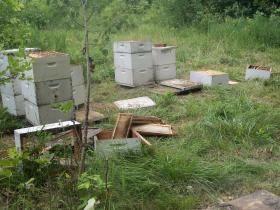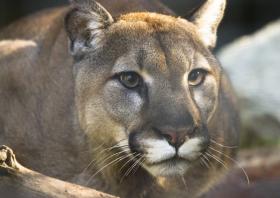https://www.google.com/url?rct=j&sa=t&url=http://www.kcci.com/news/tracks-confirm-black-bear-sighting-in-iowa/27005610&ct=ga&cd=CAEYACoTMjU3Nzk0MzgwMTQ4NDE2Njk0MDIaMDMxYmZmYzUyNjEzNzVkYTpjb206ZW46VVM&usg=AFQjCNEsUObEgOJCGXEChGMnjubHkLtlhw
Read more: http://www.kcci.com/news/
tracks-confirm-black-bear-sighting
-in-iowa/27005610#ixzz37t9ItukT
------------------------------------------------------------------------------------------------------
http://iowapublicradio.org/post/predators-come-back-iowa#.U8oBXT9WR-g.email
Tracks confirm black
bear sighting in Iowa
UPDATED 6:25 AM CDT Jul 18, 2014
The Iowa Department
of Natural Resources
has confirmed a black bear sighting in Clayton County.
of Natural Resources
has confirmed a black bear sighting in Clayton County.
Officials said the bear destroyed beehives south of the
town of Wadena. DNR
officials tracks and scat found at the scene is from a bear.
town of Wadena. DNR
officials tracks and scat found at the scene is from a bear.
The landowner reported seeing an estimated 200-pound
female bear and two cubs.
female bear and two cubs.
The DNR is continuing to investigate and confirm the
size or number of bears in the
area. They advise people to leave the bears alone,
give them plenty of space and to
not feed them.
size or number of bears in the
area. They advise people to leave the bears alone,
give them plenty of space and to
not feed them.
"Wild bears generally avoid people, keeping to
themselves and moving along," said
Vince Evelsizer, DNR furbearer and wetland
biologist. "That said, we do want people
to know there is one around, and we encourage
them to give the bear its space --
don't harass or follow the bear, especially if do
we have a female bear with cubs."
themselves and moving along," said
Vince Evelsizer, DNR furbearer and wetland
biologist. "That said, we do want people
to know there is one around, and we encourage
them to give the bear its space --
don't harass or follow the bear, especially if do
we have a female bear with cubs."
If there are cubs, they would be the first cubs
documented in Iowa in more than
140 years.
documented in Iowa in more than
140 years.
DNR officials said that once native to Iowa,
black bears have not had wild
populations in the state since the 1800s.
black bears have not had wild
populations in the state since the 1800s.
Clayton County is the county just north of
Dubuque in eastern Iowa along the
Mississippi River
.
Dubuque in eastern Iowa along the
Mississippi River
.
Read more: http://www.kcci.com/news/
tracks-confirm-black-bear-sighting
-in-iowa/27005610#ixzz37t9ItukT
------------------------------------------------------------------------------------------------------
http://iowapublicradio.org/post/predators-come-back-iowa#.U8oBXT9WR-g.email
Predators Come Back to Iowa
Thanks to hunting regulations in other states, black bears and mountain lions are returning to Iowa.
A mother black bear and her two cubs were spotted earlier this week, on the border of Fayette and Clayton Counties, in northeast Iowa. The next day, a beekeeper discovered bear scat and paw prints near some damaged hives. Also this week, theIowa Department of Natural Resources confirmed the state's first mountain lion of 2014. A deer carcass with signs of mountain lion predation was found in Cherokee County, in northeast Iowa.
For the first time in five or six generations Iowans are coming face-to-face with black bears and mountain lions. For both species, young males are traveling far distances in search of mates. These wild encounters have delighted some Iowans, while scaring or angering others.
Karl Hendriskson lives on a small farm, surrounded by woods near Decorah, in northeast Iowa. This May, he found a black bear in his front yard clinging to an evergreen, about 7 or 8 ft. in the air.
“I couldn’t believe what I was seeing…I thought it was a black lab puppy or dog up in the tree because of the snout…He turned to look at me, and I said, ‘It’s a black bear!’ So I quickly, quickly got out of here.”
Neighbors of Hendrickson’s found a pile of bear scat in their driveway and an emptied bird feeder. Bird and livestock feed left unattended attracts bears thanks to their strong sense of smell.
Iowa’s black bear population is trickling down from Wisconsin and Minnesota. The bear roaming Hendrickson’s neighborhood was likely a young male driven south into Iowa by older bears, wanting to protect their territories.
Rebecca Christoffel is wildlife extension biologist at Iowa State University. She says like black bears, young, male mountain lions are chased out of territories by older, dominate cats. “Think of yourself of as child, right about at 17 or 18," says Christoffel. "Mom and dad are saying the same things, ‘Hey, time to fledge, get out of here.’”
Since mountain lions range throughout North and South America, young cats will travel far distances. One mountain lion from South Dakota was killed after colliding with a car in Connecticut, in 2011.
With both predators, females more tolerated and therefore less likely to venture into Iowa. The cubs in eastern Iowa maybe the first black bears born in the state since the mid 1800s.
150 years ago, hunters collected bounties on large predators and this caused populations to shrink dramatically. “Every time an animal came into an area, it was worth more dead than alive," says Christoffel. "Now we no longer have bounties paid on these animals…and state agencies are going out of their way to help animals recover.”
Today, states like Minnesota and South Dakota regulate the number of large predators killed through hunting seasons, which partially accounts for the population growth. Iowa has no limits on the number of black bears and mountain lions that can be killed. This in part is because by the time the state legislature established hunting seasons, there were no black bears or mountain lions left.
Additionally, black bears and especially mountain lions were never very common in Iowa. “We simply never had a lot of really good habitat for them,” say Cristoffel. Most black bears and mountain lions spotted in Iowa are just traveling through, on a kind of road trip looking for girlfriends.
Christoffel says migration is good for the genetic diversity of a species. “Individuals from one population (move) and they’ll start breeding with individuals with another population. And that’s how you keep these populations going.”
Some Iowans like Hendrickson and his family are excited large predators are coming to Iowa, but others see these animals as a nuisance and a danger. Iowa DNR biologist Vince Evelsizer says it’s good to be cautious and encourages Iowans to contact him with concerns. He adds at most five mountain lions and about that many black bears live in Iowa,“The size of the population is very small.”
Evelsizer says the public is less accepting of mountain lions than black bears. This in part is because mountain lions are more inclined to hunt livestock. The Iowa DNR's only confirmed mountain lion sightings are of young males, meaning mountain lions are not breeding within the state. Usually the large cats originate from Nebraska and South Dakota, if not farther west.
Larry Ehert keeps about 65 head of cattle at his ranch in central Iowa. Back in May one of his calves disappeared. “The only sign of it we found, was a tail down by the creek.” Ehert thinks the fact the calf had an injured leg made it an easy meal for a mountain lion.
“The only thing I could surmise is that it was a mountain lion or a big predator. Coyotes would have killed an animal and eaten it there. It had to be something strong enough to take it over a fence. This calf probably weighed 600 lbs. And if somebody is going to steal one of my calves, that wouldn’t be the one they would have taken.”
Ehert estimates the lost calf cost him roughly $1,400 dollars. To be clear he isn’t 100-percent certain what took his animal, but there have been mountain lion sightings near Ehret's ranch. And if he sees one, he intends to kill it.
Evelsizer says Iowa is at an impasse on whether this is a good idea. “It’s definitely a grey issue. I think the more you understand the topic and the animal’s biology, and their traits, I think that would go a long way in easing some fears.” He recommends the public learning more about these animals and contacting the DNR with questions.
In the meantime, ISU's Rebecca Christoffel says there are a number of strategies to keep predators at a safe distance, "You want to right away get on it, so they don't the idea that they are welcomed to help themselves." She recommends not leaving food outside (and removing bird feeders and salt blocks,) putting up fencing, and getting a guard dog, or even a guard llama.
Both Christoffel and Evelsizer agree though it might take some adjustment, it's possible to live safely and peacefully near wild predators.
















5 comments:
I gotta nit-pick regarding the black bear range map from this article--there is a healthy, LARGE(in numbers AND size--some record size black bears in this area!) population of black bears all through eastern North Carolina--like on that cool red wolf video you had on this blog not long ago! And I'm purty sure quite a few all along several coastal areas in other states throughout the east, not shown on this map. Which, for us bear huggers, is a GOOD thing!....L B.
LB.................new Alligator National Wildlife Refuge video is posted on the home page of this blog.... with 32 Black Bears gathering in a field to feed prior to lights out--amazing!
Yeah, I watched that--cool! These eastern N. C. black bears tend to get much larger than most bears in the western N. C. mountains, where we have another large population(southern Appalachians). The easterners have lots of human planted crops to feed off of available all the time, and the mountain bears tend to have to work harder and range further to get enough to eat. The piedmont of N. C., the more populous middle portion of the state, does get occasional transients, but is far too human developed to provide very good bear habitat, and encounters with humans and autos kill them off about as fast as they show up, alas. Where I now live, in the Uwharrie Forest area COULD support some black bears(and they do show up here occasionally and briefly), but our human deer hunter population is so enormous, that any bears trying to get established get shot during the yearly inundation/saturation of hunters this patch of forest experiences every deer season(sigh).....L.B.
It is interesting that northern New Jersey, one of the most densely populated sections of the USA supports a significant Black Bear population despite it's myriad of roads and suburban structures.........Would think northern North Carolina would be able to do so as well
Most of central North Carolina is DENSELY populated now--not even much farmland left. There are only scattered patches of forest--bears would have to live in peoples' yards or mall parking lots to survive there! Not that adaptable bears couldn't do that, IF they were left alone, but they get shot about as quick as they appear in these areas. I would assume the New Jersey bears are still in spots not totally developed, like N. C.'s western and eastern portions. Still lots of roads and people in these western and eastern areas, but also plenty of forests, swamps, or farmland where the bears can hide out. Maybe it's that N. C. residents are just quicker to shoot any bear they see than Jerseyites!....L.B.
Post a Comment